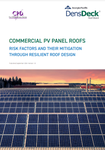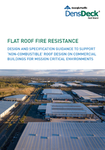As heavy electricity consumers, many data centers deploy on-site power generation through PV panels installed on their roofs to help reduce the proportion of electricity they need to draw from the grid. While this makes good commercial sense, it’s important to remember that installing PV panels can also place additional stress on the roof structure, increase existing risks, and even introduce new ones.
With this in mind, here we’ll take a look at three risk factors that can damage both the flat roof and the PV panels housed upon them, as well as how to mitigate against these risks to ensure the roof is resilient and can deliver a long lifetime of effective service.
1. Fire from PV panels
The first risk to be aware of is a particularly dangerous one – fire. The main contributing factor to solar panel flat roof fires is the electrical failure of components of PV systems. Such failures can lead to electrical arcing which, due to the intense heat, can cause combustion of surrounding materials on the roof including the waterproofing layer.
Fault tree analysis puts the annual fire incident risk at nearly 29 fires per GW of PV panels installed, 67 percent of which were caused by PV components. If the global growth of PV installations increases as expected, this could result in 900,000 to 2,000,000 roof fires by 2050.
The 24/7 nature of data center operations makes any incidence of fire particularly devastating. For example, a fire for French cloud computing company OVH Groupe SAS in Strasbourg resulted in €105 million in losses. Research also shows that 30 percent of all businesses that have a major fire fail within a year and 70 percent within five years.
Limiting the spread of fire so that it can be contained and extinguished on the rooftop, will cost significantly less than a fire that penetrates the deck because of the damage to assets and business disruption. As a result, many insurers insist the data center roof build-up must be designed to limit fire spread and penetration before PV panels can be installed.
Adding a cover board to the build-up, such as the DensDeck Roof Board, that is non-combustible with Euroclass A1 reaction to fire classification can help improve the fire performance of the roof build-up. As well as reducing potential fire spread across the surface of the waterproofing layer, it can help increase fire resistance, thus helping to reduce the rate of fire penetration.
For ease of specification, opt for roof assemblies that are ‘FM approved’ by the testing arm of FM (formerly FM Global), many of which include roof cover boards to increase their fire-resistant properties, making them ideal for use with PV panels. It’s worth bearing in mind that in May 2024, 59 percent of the almost 1.2 million roof assemblies in RoofNav, FMs roof assembly database, contained a cover board, of which, 53 percent of the cover boards were DensDeck Roof Boards.
2. Increased loading and foot traffic
The second risk from installing PV panels is the increased loading that will be placed on the building’s structure and the amount of foot traffic on the roof that will be required because solar panels need regular maintenance.
Mechanically fixing PV panels to the structural deck should be considered as this helps transfer the loads, avoiding applying stress to the roof surface.
If this isn’t possible, PV systems can be ballasted or secured to rails welded or bonded to the roof surface. Fitting a cover board underneath the waterproofing layer can help spread the load imposed by the PV panels. This decreases the stress on the waterproofing layer as well as the risk of potential compression of the insulation.
As well as spreading equipment loads, coverboards create a smooth flat surface that can help improve bonding and provide added resistance for the waterproofing layer reducing the risk of damage by maintenance traffic.
3. Damage from weather
The third risk comes from the weather. Architects will be aware of the importance of calculating wind loads for the flat roof, but it’s important to remember that additional calculations must also be done for the PV panels. That’s because the force of the wind uplift will increase when panels are installed, which could lead to damage to both the panels themselves and to the roof build-up. The calculations will be used to determine the correct fixing patterns for PV panels based on their roof position, angle of pitch, and wind data based on the location and height of the building.
Including roof cover boards within the assembly can help support the overall wind uplift resilience of the roof. Cover boards serve as a smooth, robust substrate to which the waterproofing layer can be adhered or mechanically attached effectively.
The strong, flat surface cover boards can also help reduce water ponding on the roof. Water ponding can promote localized damage to the waterproofing layer and lead to areas of weakness that could be exploited by wind uplift.
But wind isn’t the only weather event that can affect PV panels – according to the USA’s Federal Energy Management Program, severe hail is the greatest contributor to insured losses on solar PV systems worldwide.
You can reduce the risk by choosing PV Panel systems with a front glass module thickness of 3.2mm or more and ensuring manufacturers have conducted hail tests. If hail is predicted, positioning panels vertically can also help to minimize damage, while powering the system down before a hailstorm and checking for damage and electrical faults before powering it back up will reduce the risk of fire.
Hail can also weaken certain roof materials such as flexible membranes. Selecting a roof assembly that has been tested and proven to provide resilience, including resistance to hail strikes, will help to mitigate this risk. These assemblies usually include a flat roof cover board under the membrane as this can help to provide additional support to the waterproof layer when it is subject to hail strikes.
These three causes of flat roof failure can all have devastating consequences such as downtime for data centers, but they are easy to mitigate against. Adding non-combustible coverboards such as DensDeck Roof Boards can help increase the fire performance of the roof build-up, spread loads and improve the durability and resiliency of the waterproofing membrane, helping to ensure the PV panel roof continues to deliver the required performance over its lifetime.
For further information on these topics, register to download our whitepaper.
More from Georgia Pacific
-

Commercial PV Panel Roofs
Risk factors and their mitigation through resilient roof design.
-

Sponsored Fire and solar panels: How to mitigate the risk
The need for greater fire resiliency in flat roofs
-

Flat roof fire resistance
Design and specification guidance to support 'non-combustible' roof design on commercial buildings for mission critical environments.

